Top Rankings
Ann Arbor School District ranks among the top 20% of public school district in Michigan for:
Category
Attribute
Overall Rank
Highest overall rank (Top 10%)
Math Proficiency
Highest math proficiency (Top 10%)
Reading/Language Arts Proficiency
Highest reading/language arts proficiency (Top 10%)
Science Proficiency
Highest science proficiency (Top 10%)
Diversity
Most diverse schools (Top 1%)
Community Size
Largest student body (number of students) (Top 1%)
Student Attention
Lowest student:teacher ratio (Top 1%)
For the 2025 school year, there are 7 public middle schools serving 4,425 students in Ann Arbor School District. This district's average middle testing ranking is 10/10, which is in the top 10% of public middle schools in Michigan.
Public Middle Schools in Ann Arbor School District have an average math proficiency score of 53% (versus the Michigan public middle school average of 31%), and reading proficiency score of 65% (versus the 44% statewide average).
The top ranked public middle schools in Ann Arbor School District are Clague Middle School, Slauson Middle School and Ann Arbor Steam At Northside School. Overall testing rank is based on a school's combined math and reading proficiency test score ranking. Minority enrollment is 48% of the student body (majority Black and Asian), which is more than the Michigan public middle school average of 42% (majority Black).
Overview
This School District
This State (MI)
# Schools
32 Schools
1,349 Schools
# Students
16,670 Students
537,315 Students
# Teachers
1,165 Teachers
31,652 Teachers
Student : Teacher Ratio
14:1
14:1
District Rank
Ann Arbor School District, which is ranked within the top 10% of all 851 school districts in Michigan (based off of combined math and reading proficiency testing data) for the 2021-2022 school year.
The school district's graduation rate of 89% has decreased from 90% over five school years.
Overall District Rank
#50 out of 866 school districts
(Top 10%)
(Top 10%)
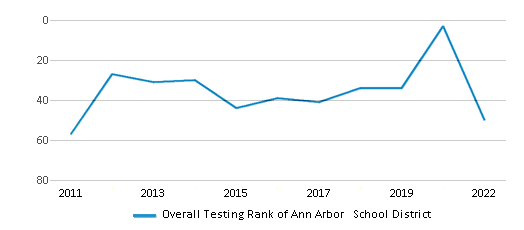
Math Test Scores (% Proficient)
56%
34%
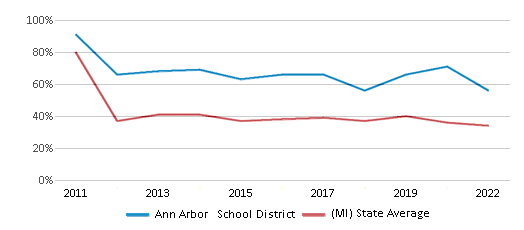
Reading/Language Arts Test Scores (% Proficient)
65%
45%
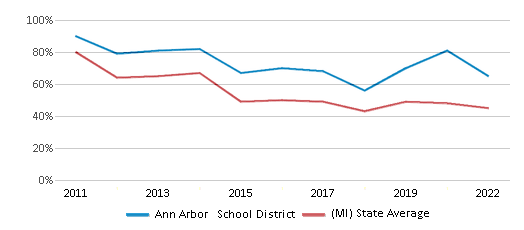
Science Test Scores (% Proficient)
58%
38%
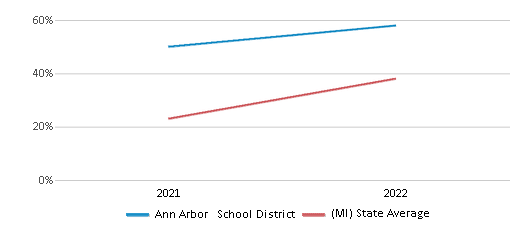
Graduation Rate
89%
81%
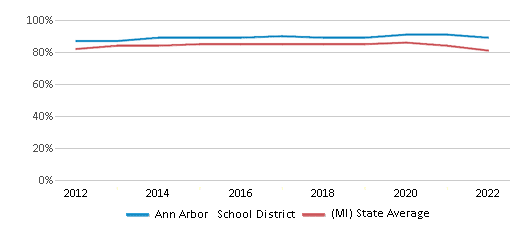
Students by Ethnicity:
Diversity Score
0.69
0.60
# American Indian Students
21 Students
5,345 Students
% American Indian Students
n/a
1%
# Asian Students
2,242 Students
19,936 Students
% Asian Students
13%
4%
# Hispanic Students
1,798 Students
47,905 Students
% Hispanic Students
11%
9%
# Black Students
2,169 Students
122,970 Students
% Black Students
13%
23%
# White Students
8,427 Students
312,168 Students
% White Students
51%
58%
# Hawaiian Students
4 Students
471 Students
% Hawaiian Students
n/a
n/a
# Two or more races Students
2,009 Students
27,717 Students
% of Two or more races Students
12%
5%
Students by Grade:
# Students in PK Grade:
-
-
# Students in K Grade:
1,514
17,744
# Students in 1st Grade:
1,189
17,631
# Students in 2nd Grade:
1,253
18,045
# Students in 3rd Grade:
1,281
17,646
# Students in 4th Grade:
1,224
18,813
# Students in 5th Grade:
1,280
26,385
# Students in 6th Grade:
1,151
87,228
# Students in 7th Grade:
1,258
103,285
# Students in 8th Grade:
1,200
102,692
# Students in 9th Grade:
1,319
33,855
# Students in 10th Grade:
1,291
31,157
# Students in 11th Grade:
1,302
30,339
# Students in 12th Grade:
1,408
30,343
# Ungraded Students:
-
2,152
District Revenue and Spending
The revenue/student of $20,878 is higher than the state median of $18,510. The school district revenue/student has stayed relatively flat over four school years.
The school district's spending/student of $19,624 is higher than the state median of $17,693. The school district spending/student has stayed relatively flat over four school years.
Total Revenue
$348 MM
$25,476 MM
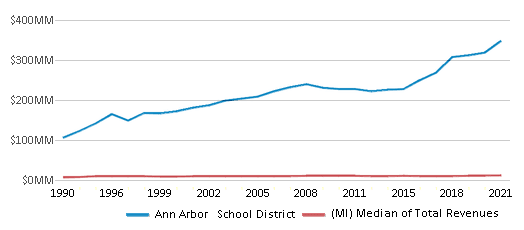
Spending
$327 MM
$24,351 MM
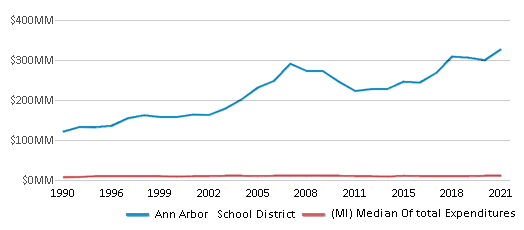
Revenue / Student
$20,878
$18,510
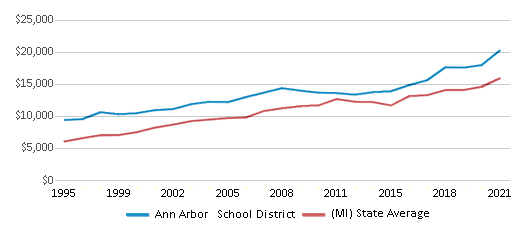
Spending / Student
$19,624
$17,693
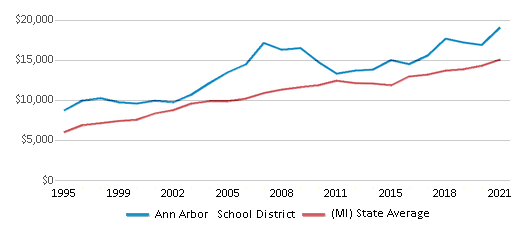
Best Ann Arbor School District Public Middle Schools (2025)
School
(Math and Reading Proficiency)
(Math and Reading Proficiency)
Location
Grades
Students
Rank: #11.
Clague Middle School
(Math: 68% | Reading: 77%)
Rank:
Rank:
10/
Top 5%10
2616 Nixon Rd
Ann Arbor, MI 48105
(734) 994-1976
Ann Arbor, MI 48105
(734) 994-1976
Grades: 6-8
| 661 students
Rank: #22.
Slauson Middle School
(Math: 56% | Reading: 74%)
Rank:
Rank:
10/
Top 10%10
1019 W Washington St
Ann Arbor, MI 48103
(734) 994-2004
Ann Arbor, MI 48103
(734) 994-2004
Grades: 6-8
| 743 students
Rank: #33.
Ann Arbor Steam At Northside School
(Math: 60% | Reading: 69%)
Rank:
Rank:
10/
Top 10%10
912 Barton Dr
Ann Arbor, MI 48105
(734) 994-1958
Ann Arbor, MI 48105
(734) 994-1958
Grades: K-8
| 599 students
Rank: #44.
Ann Arbor Open At Mack School
(Math: 55% | Reading: 68%)
Rank:
Rank:
9/
Top 20%10
920 Miller Ave
Ann Arbor, MI 48103
(734) 994-1910
Ann Arbor, MI 48103
(734) 994-1910
Grades: K-8
| 541 students
Rank: #55.
Tappan Middle School
(Math: 56% | Reading: 66%)
Rank:
Rank:
9/
Top 20%10
2251 E Stadium Blvd
Ann Arbor, MI 48104
(734) 994-2011
Ann Arbor, MI 48104
(734) 994-2011
Grades: 6-8
| 640 students
Rank: #66.
Forsythe Middle School
(Math: 56% | Reading: 64%)
Rank:
Rank:
9/
Top 20%10
1655 Newport Rd
Ann Arbor, MI 48103
(734) 994-1985
Ann Arbor, MI 48103
(734) 994-1985
Grades: 6-8
| 612 students
Rank: #77.
Scarlett Middle School
(Math: 21% | Reading: 38%)
Rank:
Rank:
4/
Bottom 50%10
3300 Lorraine St
Ann Arbor, MI 48108
(734) 997-1220
Ann Arbor, MI 48108
(734) 997-1220
Grades: 6-8
| 629 students
Recent Articles

Year-Round Or Traditional Schedule?
Which is more appropriate for your child? A year-round attendance schedule or traditional schedule? We look at the pros and cons.

Why You Should Encourage Your Child to Join a Sports Team
Participating in team sports has a great many benefits for children, there is no doubt. In this article you will learn what those benefits are.

White Students are Now the Minority in U.S. Public Schools
Increasing birth rates among immigrant families from Asia and Central and South America, combined with lower birth rates among white families, means that for the first time in history, public school students in the United States are majority-minority. This shift in demographics poses difficulties for schools as they work to accommodate children of varying language abilities and socio-economic backgrounds.





